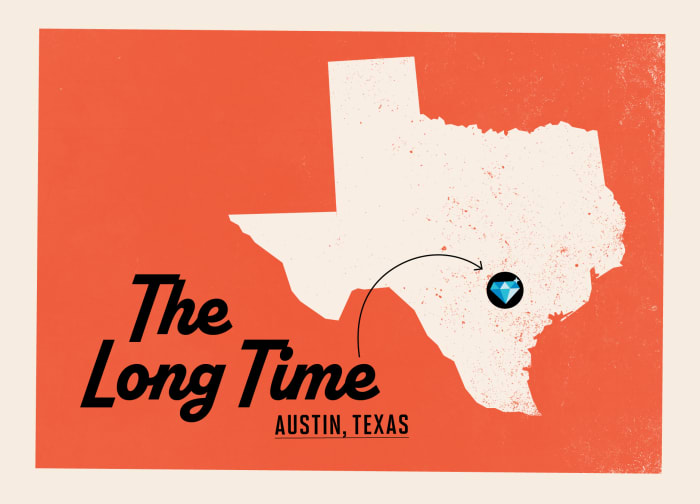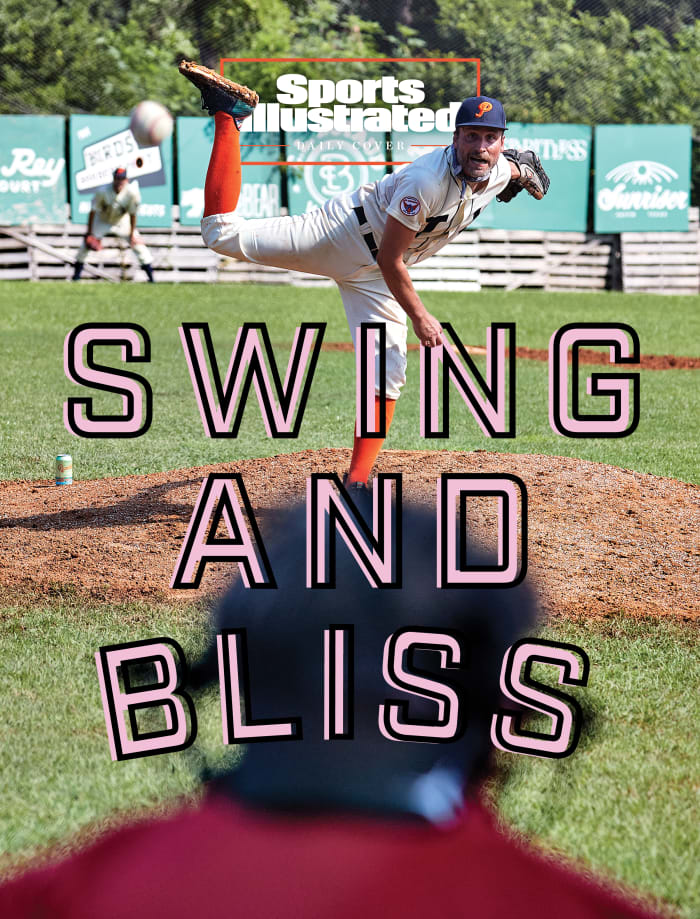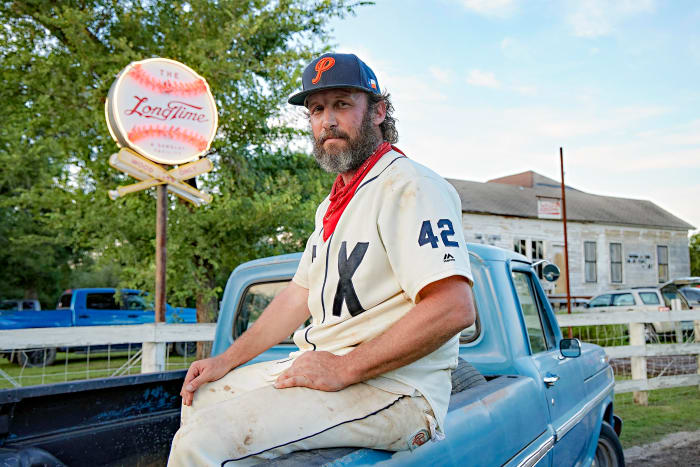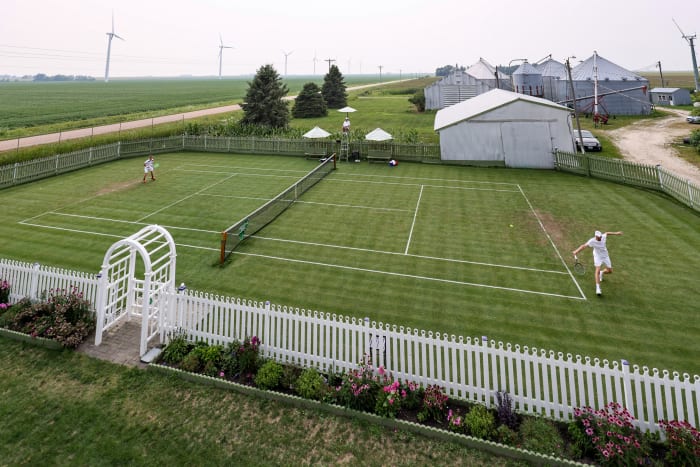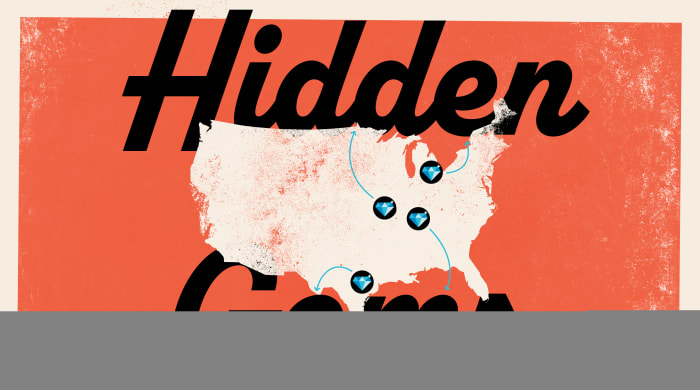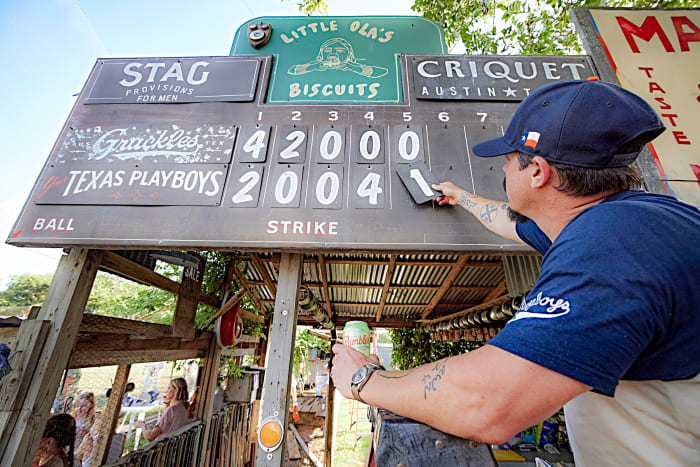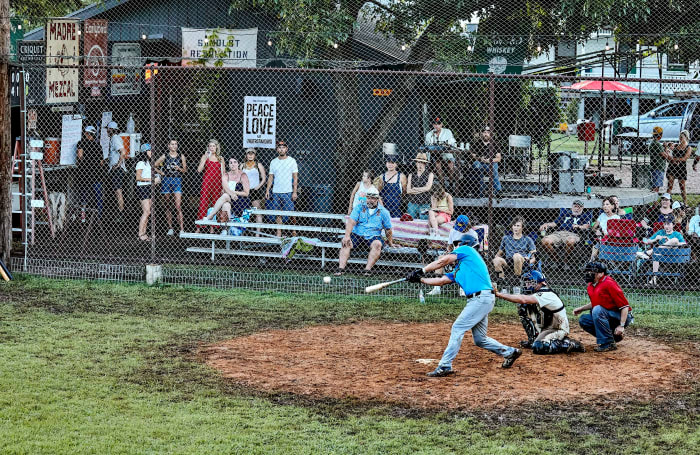
[ad_1]
America is full of sports wonders, but they aren’t always easy to find. The October 2021 issue of Sports Illustrated spotlights Hidden Gems across the country, from a Wimbledon replica in heartland farm country to a custom-built sandlot baseball field in Texas. As it turns out, there’s nothing like feeling the magic of sports in places you’d least expect.
The playing rules at the Long Time are not so much rules as they are an ethos. Both dugouts must abide by them. They go like this:
1. If you hit a home run, you should bat from the other side your next time up, no matter your switch-hitting ability.
2. If you follow Rule No. 1 and homer again, your next plate appearance should be with the huge, heavy bat that exists just for this purpose. Her name is Gracie.
3. If your team hits five home runs, any additional balls that leave the yard should be considered outs, not dingers.
4. Everyone gets a chance to hit.
These might seem like simple attempts at eccentricity, a quirky revision of the long list of recent suggestions to make baseball more fun. They are not. (For one thing, if you’re at the Long Time, you believe that baseball is already plenty fun.) Instead, these rules are like anything else at this ball field on the eastern outskirts of Austin, which is to say that they have been designed with care and purpose.
The Long Time is the home park of the Texas Playboys, a sandlot club of mostly musicians, photographers, filmmakers and other artists. Their captain is first baseman and pitcher Jack Sanders, who is also the team founder and the man who built the ball field from the ground up. The Playboys existed before they had a diamond of their own, playing in Austin parks and going on short road trips. But for five years now they’ve made their home at the Long Time. Hundreds of season-ticket holders come not only to watch the Playboys face teams from around the region but also to catch whatever other performances might be in store from a club full of creatives—say, an acoustic set from a player’s new record during the seventh-inning stretch.
For Sanders, 45, the Long Time is an extension of his architectural practice. The place is made largely from found materials, with scrap metal salvaged from a vodka distillery and a home dugout that used to be an old chicken coop. Every part of it is thoughtfully constructed—the hand-lettering on the outfield signs, the modest stage behind the bleachers, the bistro lights strung behind the backstop. On a sticky July night Sanders looked out at the field after a doubleheader, sipping a beer to a soundtrack of crickets while the last of the sun slipped away behind him. He reached for a term that an architecture professor of his would use: more-than-ness.
“The best of design, and of art, is something that’s way beyond what we’re capable of imagining,” Sanders explains. “It finds its own special story.” That’s how he sees the field that he has built in this stretch of floodplain. It’s how he sees the brand of baseball that has grown here, too—freer and kinder and more interesting than anything he ever imagined.
There are adult baseball leagues of varying structures and flavors all around the country, some tethered to tradition and some freewheeling, some competitive and some very much not. But sandlot ball is its own particular category. It doesn’t have to be played on an actual sandlot, but it does have to feel as if it could be, with the same energy and possibility invited by a vacant neighborhood patch. It’s meant to evoke the baseball you played when you were a kid, even before Little League, when all you knew was that you loved the game.
The Playboys don’t belong to any formal organization so much as to a loose confederation of teams joined by “a common thread,” says Dave Mead, a photographer who has been on the Playboys’ roster since their first game, in 2006. The logistics that might otherwise be handled by a league infrastructure all get worked out eventually. It’s more important that everyone is on board with the spirit of the thing. Joining the Playboys or another sandlot squad is less about playing ability than cultural fit. (There are no formal tryouts, but there are “vibe checks,” as one visiting South Austin Parakeets player puts it.) Throwback uniforms, whimsical team names and elaborate pregame rituals are critical. The score is not.
When Sanders was studying architecture at Auburn, he participated in an off-campus design program called the Rural Studio, in Newbern, Ala. He came across a baseball team there called the Tigers. The men were mostly in their 50s and 60s, playing with a sort of earnest joy that he hadn’t realized could be available to adults and using each game to raise money. The cash typically went toward flowers for funerals and dignified burials—simple, vital community needs filled by baseball, which “sort of blew my mind,” Sanders says. As his thesis project, he built a new backstop for their field. And a few years after returning to his native state to attend grad school at the University of Texas, Sanders decided to form a team of his own, with a spirit close to what he had seen in Newbern, and take it to Alabama to play the Tigers.
He started calling up friends and friends of friends, designers and architects and the like, to ask whether they wanted to join. The answer was a resounding hell yes.
“Jack is one of those people that everything he touches kind of turns to magic,” says his wife, Ann Tucker, also an architectural designer. The two were dating when he had the idea for the team, and watching him line up participants was like the Pied Piper, Tucker says.
In three days Sanders had 25 teammates. They named themselves the Texas Playboys after Bob Wills’s swing band of the 1940s. They went to face the Tigers and it was a delight, something they knew they wanted to do again. So the Playboys did—and then they started thinking about traveling elsewhere, scheduling a series with a sandlot-style team in New Orleans. What if they could play more regularly at home, in Austin, against people who felt the same way about baseball?
Far Afield: Hidden Gems Across the United States
There weren’t other local clubs that identified as sandlot at the time. But there were people intrigued by the Playboys, and as word spread and interest grew, so did the number of teams. Now there are a dozen in Austin alone, with others scattered around the state, a coalition joined physically on the field and digitally by a hashtag: #SandlotRevolution. The latter was started by a longtime Playboy, a film producer who plays catcher named Howard Carey, and is now used nationally by more than 50 teams.
It’s perhaps no surprise that a group so skeptical of authority would seek a physical space where it could play by its own rules. Sanders’s purchase in 2012 of the five acres that would become the Long Time was practical as much as it was philosophical. Every city park had a sign that read no beer allowed, not such a big deal if you were just bringing a few coolers into the dugout, but a little more complicated if you had become such an attraction that local breweries were inquiring about sponsorships. (There are now enough sponsors for a full concession stand offering not just beer but tequila, wine and more.)
A field of their own meant their own adult beverages, their own dimensions and their own rules, and a place to host concerts and film screenings. But it also meant a space to cultivate a stronger sense of community, and not just among players, their families and loyal supporters. The gate from every game—they play roughly once a month—at $10 a ticket goes to a different cause, from a nearby animal sanctuary to health care costs for low-income musicians.
Sanders has built out the Long Time gradually, adding details as they come to him, turning scrap metal into shade here and painting the dugout roof there. He draws a contrast with the work he does for clients—work he loves, but work that is naturally constrained by time and money, work that he must deliver as close to perfect as it can be, then walk away. The Long Time is work that he can grow with, that he never has to finish.
That sense of deliberation is clear not just in the park’s manmade structures but in its environmental ones. “He thinks about the elements that are important that maybe aren’t traditionally thought of as, Oh, that’s design,” says Tucker. In positioning the bleachers and bathrooms, for instance, Sanders leaned on the breeze and the shade. Early choices, like where exactly to plant a tree, have paid off over time.
“It takes a lot of work to get this place here to look green damn near all over,” says beloved 70-year-old groundskeeper Maxie Sherfield, a former neighbor of Sanders’s. “That takes a long time. There’s pride in it. . . . It’s art. It’s art of me and him together. Ain’t no place in the world like this here.”
The Playboys do not have a standard definition of sandlot, but they know it when they see it. That’s sandlot is a line they apply to art or to other sports as often as to baseball. What’s important is the ability to make your own fun, no matter how limited your resources, and your dedication to community. That’s sandlot. But everyone with the club is extremely grateful that their version is tied to the game they love.
“The thing about baseball is that it contains all the myths of America,” says Daedelus Hoffman, a sculptor who runs the season-ticket and membership program for the Playboys. “You know what I mean? It’s this perfect shorthand for all of our ideas about everything that’s great about American community, and that cuts across all different strata, ethnic groups, ages, genders. And sandlot epitomizes that—because it’s the DIY version.”
Even as Sanders notes other places where he’s felt a sandlot-type energy—a cricket game he stumbled across in Houston, soccer he witnessed in Brazil—he comes back to everything that makes baseball suited to this ideal. There is the cadence of it, the natural pockets of reflectiveness and the profound, delightful bursts of drama. There are the aesthetics—“the grass and the leather and the actual ball and bat,” Sanders says. There is the history and the capacity for surprise. There are physical rhythms that are so ingrained as to feel inherent, and there are occasionally plays no one has seen before.
Which is all to say that, yes, Sanders is romantic about baseball. But he is not naive about it. What exists at the Long Time, he thinks, can exist anywhere—and does in more places than we know. He still loves MLB. But as its brand of baseball has become increasingly driven by money and hemmed in by corporatized questions about how to increase the appeal of the game, he has found that he loves this even more.
“It’s such a misunderstanding to think that little bit of Americana—joy, blanket, hot dog, beer—has to be so hard,” Sanders says. “Like, I don’t want games here to be at a loss, or for my family to think that I’m just throwing money at some childish baseball fantasy. But I believe that this is a model that is replicable and interesting and is good fun that we can do together and build organically.”
The Texas Playboys have done that. They’re on track to donate more than $20,000 to local causes for the third straight year. (They met the goal last season, which was canceled due to the pandemic, by raising money through The Lone Run Derby, an online variety show with videos of players taking batting practice while masked as the Lone Ranger.) They have dedicated fans who love their inclusive brand of baseball. That’s evident in the stream of people who come up to Sanders after a game at the Long Time: a man who says he’d never seen the sport played this way and wants to share his joy; a teammate who cracks a joke about pick-off moves and thanks him for a day of “heaven”; Maxie, who wants to say good night; Sanders’s two children, who have spent the day running wild with other kids at the ballpark—that’s sandlot—and who want to stay in this place as long as they can.
Sanders jokes that there is no way a ballpark is the best use of this space: “Well, I bought this land; what should I do to increase the value? And none of those answers are to build a sandlot baseball field in the floodplain.” But after a doubleheader has played out according to the one-of-a-kind rulebook, and everyone has left cheerful and exhausted, and the deliberate, earnest design of this work in progress is visible by only the porch light of the old house behind home plate, it is easy to believe that the Long Time is the only answer at all.
More Hidden Gems:
• Iowa’s Court of Dreams is More Than a Wimbledon Replica
• Inside Kentucky’s Storied Lakeside Swim Club
• How Detroit City FC Fans Built Their Own Club
[ad_2]
Source link
